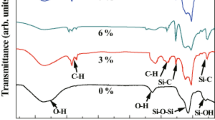Abstract
A facile and versatile method based on hydrolysis and subsequent condensation of silica alkoxides through sol–gel approach is proposed to obtain an internal-hydrophobic and surface-hydrophilic silica aerogel monoliths. Wet gel monoliths were modified in turn by the hydrophobic agent trimethychlorosilane (TMCS) and hydrophilic modifier 3-aminopropylsilanetriol and finished with supercritical CO2 drying. The silica aerogels were characterized by scanning electron microscopy (SEM), fourier transform infrared spectroscopy (FT-IR), water contact angle, and microcomputer-controlled electron universal tests. The characterization on microstructure of prepared internal-hydrophobic and surface-hydrophilic silica aerogel monoliths indicated that the monoliths have a typical network structure with a porous interior, which exhibits hydrophobic performance (Max. contact angle = 137°) and a hydrophilic surface (Min. contact angle = 60°). The dually modified silica aerogel monoliths were coated with a pure acrylic emulsion layer through which the compressive strength was enhanced greatly which proved that the proposed approach is valuable to silica aerogel modification.

Highlights
-
The monoliths have a typical network structure with a porous interior, which exhibits hydrophobic performance (Max. contact angle = 137°), and a hydrophilic surface (Min. contact angle = 60°).
-
The dually modified silica aerogel monoliths were coated with a pure acrylic emulsion layer through which the compressive strength was enhanced greatly.










Similar content being viewed by others
References
Tamon H, Sone T, Okazaki M (1997) Control of mesoporous structure of silica aerogel prepared from TMOS. J Colloid Interf Sci 188(1):162–167
Leventis N, Elder IA (1999) Durable modification of silica aerogel monoliths with fluorescent 2,7-diazapyrenium moieties. Sensing oxygen near the speed of open-air diffusion. Chem Mater 11(10):2837–2845
Mohanan J, Brock SH (2003) Influence of synthetic and processing parameters on the surface area, speciation, and particle formation in copper oxide/silica aerogel composites. Chem Mater 15(13):2567–2576
Prakash S, Jeffreybrinker C, Hurd A (1995) Silica aerogel films at ambient pressure. J Non-Cryst Solids 190(3):264–275
Soleimanidorcheh A, Abbasi MH (2008) Silica aerogel; synthesis, properties and characterization. J Mater Process Technol 199(1–3):10–26
Alnaief M, Smirnova I (2011) In situ production of spherical aerogel microparticles. J Supercrit Fluids 55(3):1118–1123
Pierre A, Pajonk GRM (2002) Chemistry of aerogels and their applications. Chem Rev 102(11):4243–4265
Zhang HX, Qiao YJ, Zhang XH (2010) Structural and thermal study of highly porous nanocomposite SiO2-based aerogels. J Non-Cryst Solids 356(18–19):879–883
Wang SW, Kim TY, Yun SH (2010) Effect of surface modification conditions on the synthesis of mesoporous crack-free silica aerogel monoliths from waterglass via ambient-drying. Microporous Mesoporous Mater 130(1–3):295–302
Tamon H, Kitamura T, Okazaki M (1998) Preparation of silica aerogel from TEOS. J Colloid Interf Sci 197(2):353–359
Kim S, Shin S, Lenhardt J (2013) Deterministic control over high-Z doping of polydicyclopentadiene-based aerogel coatings. ACS Appl Mater Interfaces 5(16):8111–8119
Jeong AY, Mankoo S, Pyokim D (2000) Characterization of hydrophobic SiO2 powders prepared by surface modification on wet gel. J Sol-Gel Sci Technol 19(1–3):483–487
Schmidt M, Schwertfeger F (1998) Applications for silica aerogel products. J Non-Cryst Solids 225(1):364–368
Shi JJ, Lu LB, Guo WT (2013) Heat insulation performance, mechanics and hydrophobic modification of cellulose–SiO2 composite aerogels. Carbohyd Polym 98(1):282–289
Venkateswara Rao A, Kulkarni M, Amalnerkar DP (2003) Surface chemical modification of silica aerogel using various alkyl-alkoxy/chloro silanes. Appl Surf Sci 206(1–4):262–270
Sarawade P, Kim JK (2011) Synthesis of sodium silicate-based hydrophilic silica aerogel beads with superior properties: effect of heat-treatment. J Non-Cryst Solids 357(10):2156–2162
Parvathy Rao A, Venkateswara Rao A, Pajonk GM (2007) Hydrophobic and physical properties of the ambient pressure dried silica aerogels with sodium silicate precursor using various surface modification agents. Appl Surf Sci 253(14):6032–6040
Bhagat S, Kim YH (2008) Superhydrophobic silica aerogel powders with simultaneous surface modification, solvent exchange and sodium ion removal from hydrogels. Microporous Mesoporous Mater 112(1–3):504–509
Nicholas L, Chakkaravarthy C, Bang A, Chariklia Sotiriou-L (2014) Cocoon-in-web-like superhydrophobic aerogels from hydrophilic polyurea and use in environmental remediation. ACS Appl Mater Interfaces 6(9):6872–6882
Kim CY, Lee JK, Kim BI (2008) Synthesis and pore analysis of aerogel-glass fiber composites by ambient drying method. Colloid Surf A Physicochem Eng Asp 313–314:179–182
Karout A, Buisson P, Perrard A (2005) Shaping and mechanical reinforcement of silica aerogel biocatalysts with ceramic fiber felts. J Sol-Gel Sci Technol 36(2):163–171
Li J, Cao JG, Li H (2012) One-step synthesis of hydrophobic silica aerogel viainsitu surface modification. Mater Lett 87(15):146–149
Ouyang ZH, Wu L, Li KB et al. (2005) Surface modification of nano-SiO2 in gas phase. Chem Ind Eng Progress 11(24):1265–1268.
Funding
This study was financially supported by the Joint Fund of the National Natural Science Foundation of China and China Academy of Engineering Physics (NSAF) (No. 11076010).
Author information
Authors and Affiliations
Corresponding author
Ethics declarations
Conflict of interest
The authors declare that they have no conflict of interest.
Additional information
Publisher’s note: Springer Nature remains neutral with regard to jurisdictional claims in published maps and institutional affiliations.
Rights and permissions
About this article
Cite this article
He, F., Cheng, J., Wu, JY. et al. Dual modification of silica aerogel monoliths. J Sol-Gel Sci Technol 90, 323–329 (2019). https://doi.org/10.1007/s10971-019-04954-z
Received:
Accepted:
Published:
Issue Date:
DOI: https://doi.org/10.1007/s10971-019-04954-z




